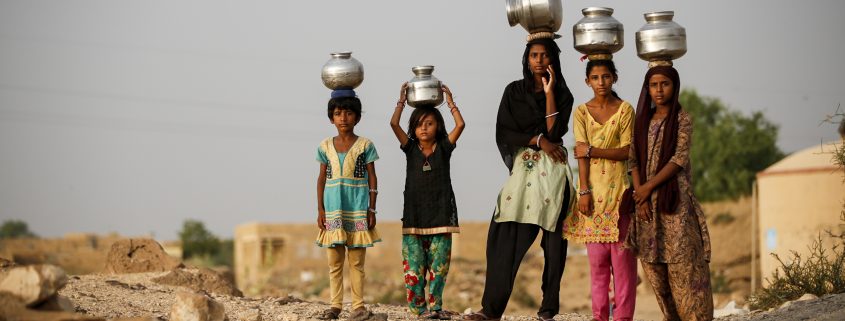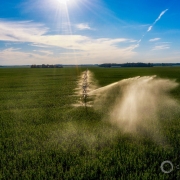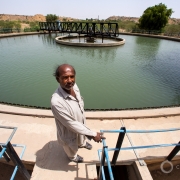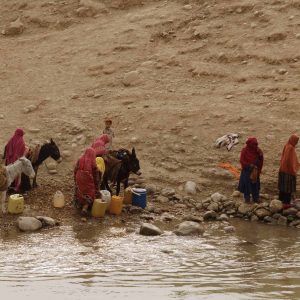What’s Up With Water – April 2, 2018
Transcripts
What’s Up With Water for April 2, 2018
I’m Eileen Wray-McCann, for Circle of Blue, and here’s What’s Up with Water, a condensation of the world’s water news.
In rural Iran, water continues to factor in protests against mismanagement, corruption and shortages. The latest demonstrations have been relatively small and isolated, but point to an increase in tensions over the course of the year. According to a local journalist, water shortages, which have disrupted the economy, are often due to poor management, and farmers have accused local officials of diverting water away from their fields in exchange for bribes.
The Islamic Republic of Iran Meteorological Organization says that about 97% of Iran is suffering drought to some extent. This makes for a potential flashpoint for violence, which Iran has seen in previous months during nationwide protests over higher food prices, corruption and lack of water in rural areas. Syria’s drought, and its anti-government protests in 2011 led to civil war. Iranian security forces, aware of the threat, acknowledge that water will be important for national and regional stability. Iran’s leaders said recently that drought needs to be addressed. But they condemned what they called “lawlessness and violence.”
In January, protesters in a town near ISS-fah-hahn Isfahan threw Molotov cocktails at a police station, and security forces fired on the crowds. One of the dead was said to be a farmer, and according to locals, water rights were at the center of the confrontation. Last year, a United Nations report said that critical water shortages have ruined agricultural livelihoods and forced people to migrate in search of work.
A number of environmentalists have been arrested this year, possibly because they have raised the profile of water stress in Iran. It’s a sensitive issue for a national government that Human Rights Watch says is hampered in its search for solutions by limited power and widespread corruption.
In India, drought is forcing farmers to move in search of work, but life is often worse for those they leave behind.
Last week’s coverage from Reuter’s Foundation illustrates the plight of those leaving home because of water shortages. In Kharkara, in India’s Bel-AHN-geer Balangir district, most of the farmers have gone to the cities, to work in brick kilns. Desperate, they debt-bonded themselves to long stretches of low-paying work in exchange for money up front to sustain their families. This means that they are absent from their villages most of the year. Those who are left behind – those too old or weak to work in the kilns, or those too poor to uproot – have ever less to support them.
Kharkara is in the Indian state of o-DEE-shah Odisha, where an estimated half million people leave each year, propelled by drought or unemployment. Over half end up at the brick kilns. o-DEE-shah’s Odisha’s western region has long suffered from diminished rainfall, but in the last three years it has withered, getting only a third of the rain that was common a few decades ago. Those remaining in abandoned villages rely on nearby forests, cutting teak trees to sell and clearing land to grow heat-tolerant cotton. But tree-cutting leads to more environmental distress, say forestry and weather officials. The lack of foliage warms the villages and halts the sudden showers that those left behind continue to hope for.
Far to the north, farmers in Nepal claim that they are being short-changed in water treaties with India. Al Jazeera’s Subina Shrestha reported last week of a farming crisis in Nepal, centered on the KAH-mellah river.
The KAH-mella is one of six thousand rivers and streams that Nepal shares with India, and it is the heart of a farm irrigation project in the DAH-nu-shah Dhanusha district of southern Nepal, near the Indian border. It was built over 40 years ago, and intended to serve both countries. River water flows past high embankments on the Nepalese side of the border. India built the embankment as part of a larger plan. A separate river was going to be diverted towards the KAH-mella River, and channels were going to bring water to the land in Nepal. But that was 40 years ago, and the channels have yet to appear. The water goes straight to India, and Nepalese farmers along the route must find ways to pump water up from the canal and over to their fields, which are parched. Many cannot sustain the effort and have left Nepal in search of income. They feel increasingly cheated by water-sharing agreements that, in their view, have favored India ever since the first one was signed in the late 1950s.
A former Indian Ambassador to Nepal acknowledged that the KAH-mella project does provide more irrigation to India because of its location, but he stated that Nepal received other benefits from the agreements, including financial assistance, road and railway construction and the high embankments that protect the land from dangerous monsoon flooding and erosion.
In Mozambique, meteorologists warn that the water supply in the capital city, muh-POO-toe Maputo, could be wiped out if an El Niño weather pattern hits the Pacific Ocean as predicted this year. This current rainy season is nearly over and has been good for most of the country. However, southwest Mozambique, like its neighbors South Africa and Swaziland, is in its fourth year of drought. El Niño means dry weather for the area, and officials are calling for water conservation measures in order to prevent muh-POO-toe Maputo from facing its own Day Zero. muh-POO-toe Maputo is a growing city, with a corresponding need for water. A dam that was supposed to increase capacity was halted by a corruption scandal, and another, farther dam won’t be ready until 2019.
And that’s What’s Up With Water…We’d like to share what’s up where you are – Tweet us with your water news: @circleofblue hash tag whatsupwithwater.
Eileen Wray-McCann is a writer, director and narrator who co-founded Circle of Blue. During her 13 years at Interlochen Public Radio, a National Public Radio affiliate in Northern Michigan, Eileen produced and hosted regional and national programming. She’s won Telly Awards for her scriptwriting and documentary work, and her work with Circle of Blue follows many years of independent multimedia journalistic projects and a life-long love of the Great Lakes. She holds a BA and MA radio and television from the University of Detroit. Eileen is currently moonlighting as an audio archivist and enjoys traveling through time via sound.











Leave a Reply
Want to join the discussion?Feel free to contribute!